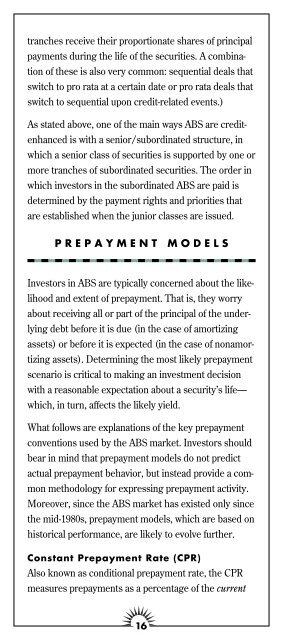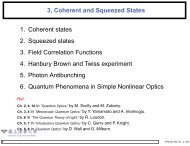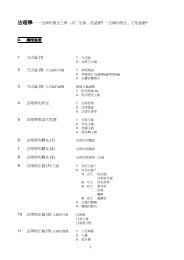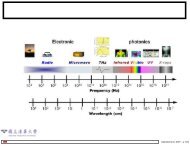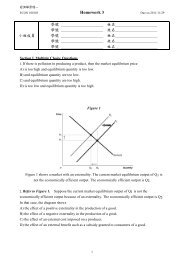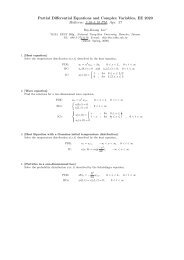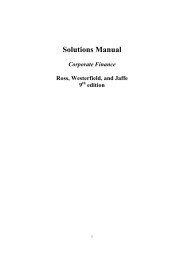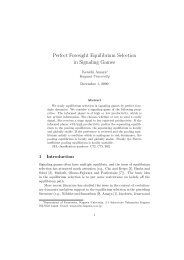assetbacked Pages
assetbacked Pages
assetbacked Pages
Create successful ePaper yourself
Turn your PDF publications into a flip-book with our unique Google optimized e-Paper software.
tranches receive their proportionate shares of principal<br />
payments during the life of the securities. A combination<br />
of these is also very common: sequential deals that<br />
switch to pro rata at a certain date or pro rata deals that<br />
switch to sequential upon credit-related events.)<br />
As stated above, one of the main ways ABS are creditenhanced<br />
is with a senior/subordinated structure, in<br />
which a senior class of securities is supported by one or<br />
more tranches of subordinated securities. The order in<br />
which investors in the subordinated ABS are paid is<br />
determined by the payment rights and priorities that<br />
are established when the junior classes are issued.<br />
PREPAYMENT MODELS<br />
Investors in ABS are typically concerned about the likelihood<br />
and extent of prepayment. That is, they worry<br />
about receiving all or part of the principal of the underlying<br />
debt before it is due (in the case of amortizing<br />
assets) or before it is expected (in the case of nonamortizing<br />
assets). Determining the most likely prepayment<br />
scenario is critical to making an investment decision<br />
with a reasonable expectation about a security’s life—<br />
which, in turn, affects the likely yield.<br />
What follows are explanations of the key prepayment<br />
conventions used by the ABS market. Investors should<br />
bear in mind that prepayment models do not predict<br />
actual prepayment behavior, but instead provide a common<br />
methodology for expressing prepayment activity.<br />
Moreover, since the ABS market has existed only since<br />
the mid-1980s, prepayment models, which are based on<br />
historical performance, are likely to evolve further.<br />
Constant Prepayment Rate (CPR)<br />
Also known as conditional prepayment rate, the CPR<br />
measures prepayments as a percentage of the current<br />
16<br />
outstanding loan balance. It is always expressed as a<br />
compound annual rate—a 10% CPR means that 10% of<br />
the pool’s current loan balance pool is likely to prepay<br />
over the next year. The CPR is commonly used to<br />
describe the prepayment experience of HELs and student-loan<br />
assets.<br />
Monthly Payment Rate (MPR)<br />
Technically, this is not a prepayment measure, because<br />
it is used with nonamortizing assets, such as credit card<br />
and dealer floor-plan receivables, which are not subject<br />
to prepayment. Rather, the MPR is a repayment measure<br />
and is calculated by dividing the sum of the interest<br />
and principal payments received in a month by the<br />
outstanding balance. The rating agencies require every<br />
nonamortizing ABS issue to establish a minimum MPR<br />
as an early-amortization trigger event; if repayments<br />
drop to that level, the security enters into early amortization.<br />
(See “Early-Amortization Risk,” on page 20.)<br />
Absolute Prepayment Speed (ABS)<br />
This abbreviation (which, confusingly, is the same as<br />
that used for asset-backed securities) is commonly<br />
applied to securities backed by auto loans, truck loans,<br />
RV loans and auto leases. Unlike CPR, which measures<br />
prepayments as a percentage of the current outstanding<br />
loan balance, the ABS calculates them as a monthly percentage<br />
of the original loan balance.<br />
Home-Equity Prepayment Curve (HEP)<br />
The HEP curve is a prepayment scale (ranging from 0%<br />
to 100%) for HELs that captures the more rapid plateau<br />
for home-equity prepayments vis - a -vis that of traditional<br />
mortgages. It is a 10-month seasoning ramp with<br />
even step-ups, terminating at the final HEP percentage<br />
in the 10th month. The standard HEP is 20%; it equals<br />
2% CPR in the first month, 4% in the second month, 6%<br />
in the third month and so on until it levels off at 20%<br />
CPR in the 10th month.<br />
17<br />
´


